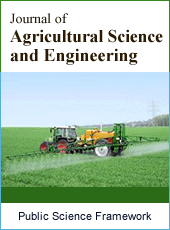Journal of Agricultural Science and Engineering
Articles Information
Journal of Agricultural Science and Engineering, Vol.1, No.5, Dec. 2015, Pub. Date: Jan. 6, 2016
The Role of Information Asymmetry in Monitoring Food Security Programme in Bar a Sub Location, Kisumu County, Second Season Harvest 2014
Pages: 193-212 Views: 3690 Downloads: 1011
[01]
Samuel Jerry Odindo, Department of Health System Management, Faculty of Community Health and Development, Great Lakes University of Kisumu, Kisumu, Kenya.
[02]
Aaron Mwayi, Department of Health Promotion, Faculty of Community Health and Development, Great Lakes University of Kisumu, Kisumu, Kenya.
[03]
Dan Odhiambo Odindo, Department of Health System Management, Faculty of Community Health and Development, Great Lakes University of Kisumu, Kisumu, Kenya.
[04]
Winnie Otieno, Department of Environmental Health, Faculty of Community Health and Development, Great Lakes University of Kisumu, Kisumu, Kenya.
[05]
Caro Akinyi, Department of Research and Measurement, Faculty of Community Health and Development, Great Lakes University of Kisumu, Kisumu, Kenya.
[06]
Jeremie Nzanzu, Department of Research and Measurement, Faculty of Community Health and Development, Great Lakes University of Kisumu, Kisumu, Kenya.
This is a longitudinal research that monitored the same households for the second seasons and later on displays the information to the farmers on a noticeboard as a way of sensitizing them on good farm management practices. The indicators have been grouped into six variables which are arranged in a consequential order. These variables include land cultivation, irrigation, land value addition, crop protection, production and sales. The variable of production is our major concern in this MEFOSEP programme. Knowledge dissemination through noticeboard and training is used as an intervention put in place as independent variables to propel an increase on the four dependent variables which have a direct output to the resultant production. Key findings was analyzed and used to determine the role of the information on the notice board in increasing food production and also to determine the previous planned variables that are associated with production of food crops in ‘Bar A’ sub location, as a way of eradicating poverty and hunger in the sub location. Census was done for the 620 households. Frequency were run using SPSS and Chi square test to determine the associations of farm indicators, such as quantity of fertilizer and seeds application on the production of maize, beans, groundnuts and vegetables. Logistic regression analysis was used to determine the significant influence of the variables on the production of monitored food crops. Comparative analysis was used to test the null hypothesis on the statistic significant between first season and second season. The rates indicators used in the participatory planning, was used to set standard harvest indicators for each an every indicator. These standard harvest indicators formulated our discussion as we compare the findings with it together with the first season findings and the second season target plan.
Monitoring Food Security, Information Asymmetry, Food Production, Rate Indicators, Standard Harvest Indicators, Target Plan, Productivity Index Table
[01]
Buruchara R., Chirwa R., Sperling L., Mukankusi C., Rubyogo J C., Muthoni R and Abang M M 2011. Development and delivery of bean varieties in Africa: The PAN Africa bean research alliance (PABRA) Model.
[02]
Department for international Development, 2002. Soil Fertility and Nutrient Management.
[03]
Dey R., 2002. Assessment of soil fertility and productivity: A micro level study.
[04]
Dharmasiri, L M., 2009. Measuring Agricultural Productivity Using the Average Productivity Index (API).
[05]
Kansas State University 2013, The role of nitrogen fertilizer in soil PH levels.
[06]
Kibet C., 2011. Major Challenge’s facing Kenyan Agricultural sector.
[07]
Mangabat, M C., and Mota, A A., 2004. Productive Indices of Selected Agricultural Commodities in the Philippines.
[08]
Mosaic Fertilizer Technology Research Centre - April 2013 - Fertilizers and Soil Acidity.
[09]
Morgado L B and Willey R W., 2003. Effects of plant population and nitrogen fertilizer on yield and efficiency of maize-bean intercropping.
[10]
My market research method 2012. Dependent vases independent variables. What’s the difference?
[11]
Niringiye C S., Ssekabembe C S and Kyamanywa S 2015, Effects of plant population on yield of maize and climbing beans growing in intercropping system.
[12]
Odindo, S, J., Odindo, D, O and Mwayi, A., (2015). The role of information asymmetry in monitoring food security programme in Bar A sub location Kisumu county.
[13]
Rebecca Lines-Kelly 2004, Don't let nitrogen acidify your soil.
[14]
Yadavendra1, J.P., Patel, V.P. and Witcombe, J.R. 2004. The impact of new maize and rice varieties on the livelihoods of poor farmers in marginal agricultural areas of western India.

ISSN Print: 2381-6821
ISSN Online: 2381-6848
Current Issue:
Vol. 7, Issue 4, December Submit a Manuscript Join Editorial Board Join Reviewer Team
ISSN Online: 2381-6848
Current Issue:
Vol. 7, Issue 4, December Submit a Manuscript Join Editorial Board Join Reviewer Team
| About This Journal |
| All Issues |
| Open Access |
| Indexing |
| Payment Information |
| Author Guidelines |
| Review Process |
| Publication Ethics |
| Editorial Board |
| Peer Reviewers |


